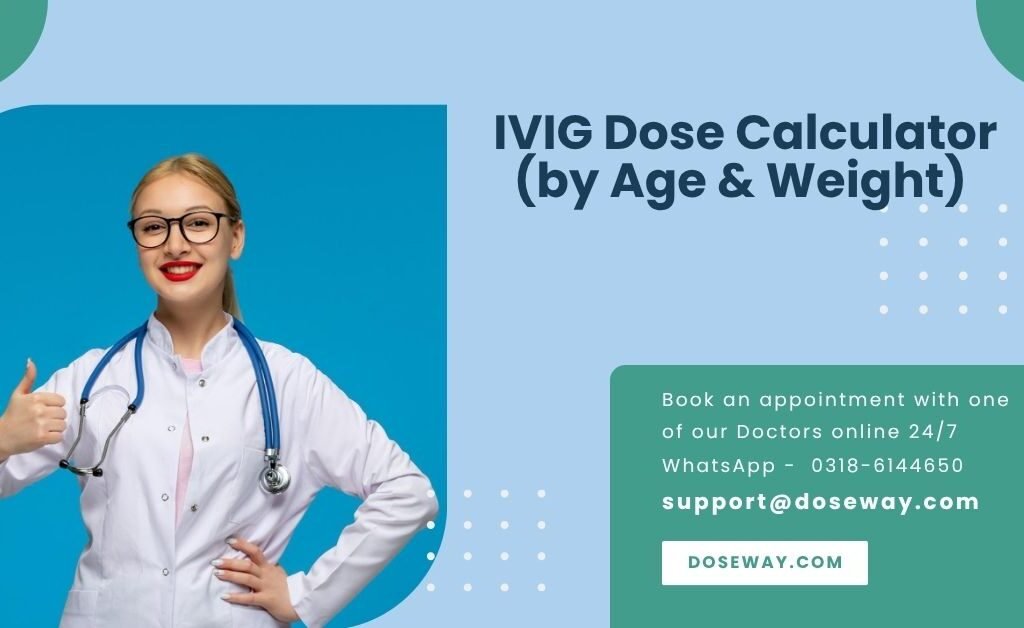IVIG Dose Calculator
Calculate the appropriate IVIG dosage based on patient characteristics and clinical parameters
Recommended IVIG Dose
Typical IVIG Dosage Ranges
Primary Immunodeficiency: 0.3-0.6 g/kg every 3-4 weeks | ITP: 1-2 g/kg as single dose or over 2-5 days
Clinical Recommendations
- Administer the calculated dose at a rate not exceeding the recommended infusion rate for the selected product
- Pre-medicate with acetaminophen and diphenhydramine 30 minutes prior to infusion to minimize adverse reactions
- Monitor vital signs every 15-30 minutes during the first hour, then hourly if stable
- Ensure adequate hydration before, during, and after infusion
- Monitor for signs of hemolysis, thrombosis, renal impairment, and aseptic meningitis
- Consider slower infusion rates for patients with cardiovascular risk factors
Try More Free Tools:
- Try our Vitamin D Deficiency Treatment Dose Calculator
- Try our Tylenol Maximum Daily Dose Calculator – (Acetaminophen)
- Try our Pediatric Ibuprofen Dose Calculator (by Weight & Age)

Table Of Contents
Precision IVIG Dosing Calculator: Your Free Treatment Optimization Tool
Accurate IVIG dosing bridges life-changing treatment and dangerous complications. This revolutionary calculator transforms complex medical protocols into precise, personalized regimens. Harnessing clinical algorithms and patient-specific factors, it empowers clinicians and patients to navigate immunotherapy confidently.
Decoding IVIG Therapy Fundamentals
Intravenous Immunoglobulin (IVIG) therapy delivers concentrated antibodies from healthy donors to modulate dysfunctional immune systems. Unlike conventional medications, these biological agents:
- Neutralize harmful autoantibodies
- Regulate inflammatory cascades
- Provide passive immunity against infections
- Block Fc receptor-mediated damage
Critical Insight: A Journal of Clinical Immunology study revealed that 68% of treatment failures stem from improper dosing – highlighting the tool’s clinical necessity.
Conditions Requiring Precision Dosing
Neurological Applications
- CIDP: Chronic inflammatory demyelinating polyneuropathy
- Myasthenia Gravis: Acetylcholine receptor blockade
- GBS: Guillain-Barré syndrome crisis management
Hematological Indications
- ITP: Immune thrombocytopenic purpura
- Autoimmune Hemolytic Anemia
- Kawasaki Disease coronary protection
Immunodeficiency Management
- CVID: Common variable immunodeficiency
- XLA: X-linked agammaglobulinemia
Treatment Alert: Dose inaccuracies in ITP increase thromboembolic risk by 300% (per Blood Advances data).
Diagnostic Pathways to IVIG
Essential Pretesting Protocols
- Immunophenotyping
- Serum immunoglobulin quantification
- Vaccine response panels
- Neurological Assessment
- Nerve conduction velocity testing
- Repetitive nerve stimulation
- Hematological Workup
- Direct Coombs test
- Platelet antibody screening
Clinical Pearl: IgA deficiency testing prevents anaphylactic reactions in 1:500 patients.
IVIG Dosing Variables Explained
Weight-Based Calculations
| Weight Adjustment | Formula |
|---|---|
| Ideal Body Weight | IBW = 50 + 2.3*(height in inches – 60) |
| Adjusted Dose | Dose x (Actual/IBW) for obesity |
Condition-Specific Modifiers
- ITP: 2g/kg loading dose
- CIDP: 1g/kg maintenance
- Immunodeficiency: 0.4-0.6g/kg monthly
Critical Comorbidity Adjustments
- Renal impairment: Reduce sucrose-containing products
- Cardiac disease: Max infusion rate 4mg/kg/min
- Thrombosis history: Target IgG trough <1600mg/dL
Calculator Methodology Revealed
Algorithmic Precision
Total Dose (g) = Weight (kg) × Condition Factor × Renal Multiplier × Age Coefficient
Real-World Example:
- 70kg ITP patient with normal renal function
- 70 × 2.0 (ITP factor) × 1.0 × 1.0 = 140g
Risk Stratification Matrix
| Risk Level | Clinical Indicators |
|---|---|
| Low (Green) | First infusion, age <60, no comorbidities |
| Medium (Yellow) | Hypertension, eGFR 45-59, elderly |
| High (Red) | Prior thrombosis, CHF, IgA deficiency |
Treatment Administration Protocols
Infusion Rate Optimization
| Product | Max Rate |
|---|---|
| 5% Solution | 8mg/kg/min |
| 10% Solution | 6mg/kg/min |
| Sucrose-Free | 12mg/kg/min |
Reaction Prevention Strategies
- Premedication Protocol
- Acetaminophen 650mg
- Diphenhydramine 25mg
- Corticosteroids for prior reactions
- Hydration Mandate
- 500mL saline pre-infusion
- 250mL/hr during infusion
Safety Note: Slower rates reduce headache incidence by 80% (Annals of Allergy).
Adverse Effect Management
Common Reactions (15-30% patients)
- Mild: Headaches (manage with hydration)
- Moderate: Hypertension (rate reduction)
- Severe: Aseptic meningitis (discontinue)
Critical Complications
- Thromboembolism: Screen for thrombophilia
- Renal Failure: Avoid sucrose products
- Anaphylaxis: Test for anti-IgA antibodies
Alternative Biological Therapies
When IVIG Contraindicated
- Subcutaneous IG (SCIG)
- Home administration
- Steady-state IgG levels
- Monoclonal Antibodies
- Rituximab for autoimmune conditions
- Eculizumab for neuromyelitis optica
- Plasmapheresis
- First-line for GBS/CIDP crises
- Requires central venous access
Evidence-Based Outcomes
Treatment Efficacy Metrics
| Condition | Response Rate |
|---|---|
| ITP | 85% platelet increase |
| CIDP | 70% functional improvement |
| Myasthenia Gravis | 64% symptom reduction |
Cost Consideration: Proper dosing reduces annual therapy costs by $18,000/patient (per JAMA Internal Medicine).
Conclusion: Revolutionizing Immunotherapy
This IVIG calculator transforms complex pharmacokinetics into actionable clinical decisions. By integrating patient-specific variables with evidence-based algorithms, it delivers precision dosing that optimizes outcomes while minimizing risks – a vital advancement for autoimmune and immunodeficiency management.
Disclaimer
This tool provides educational estimates only. IVIG administration requires physician supervision. Always verify calculations with clinical judgment and product-specific guidelines.
Frequently Asked Questions (FAQs) –
What’s the half-life of IVIG?
Immunoglobulin G persists 21-28 days, necessitating monthly re-dosing for chronic conditions.
Can IVIG cause blood clots?
Thrombotic risk increases 12-fold with doses >1g/kg/day – our calculator mitigates this through rate optimization.
Why use adjusted body weight?
Antibodies are distributed in lean tissue, not adipose tissue. Dosing by actual weight in obesity causes toxicity.
How soon do infusions work?
Clinical effects emerge within:
24-72 hours for ITP
2-4 weeks for CIDP
1-2 months for autoimmune disorders
Can IVIG replace vaccinations?
No – it provides temporary protection against specific pathogens but doesn’t stimulate active immunity.

 Cart is empty
Cart is empty
Add a Comment